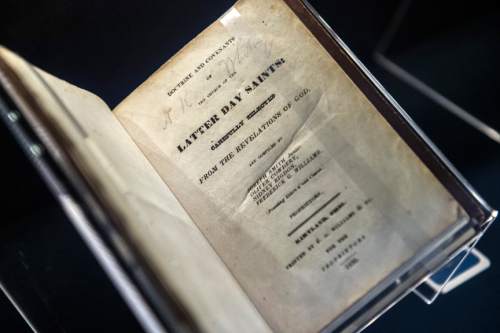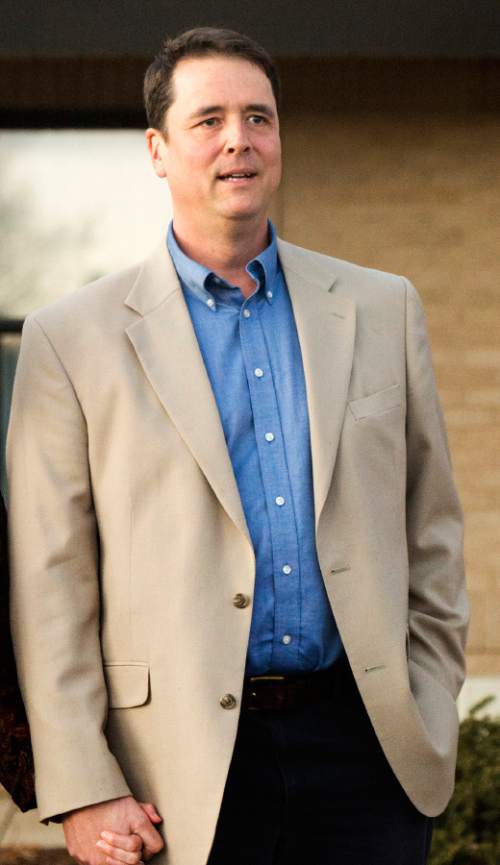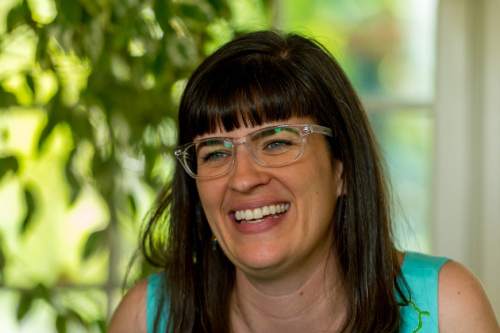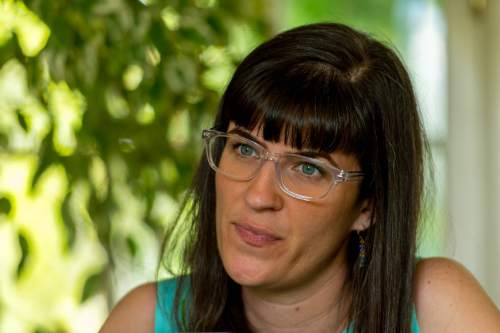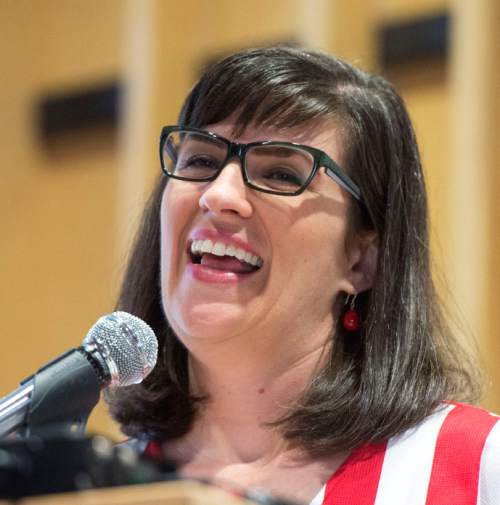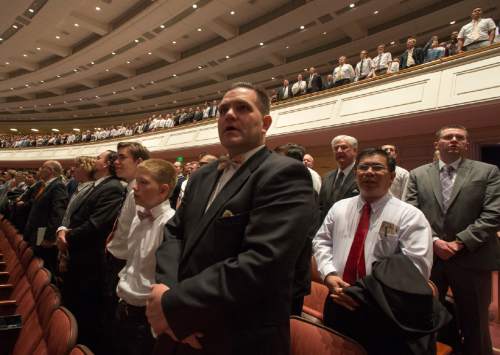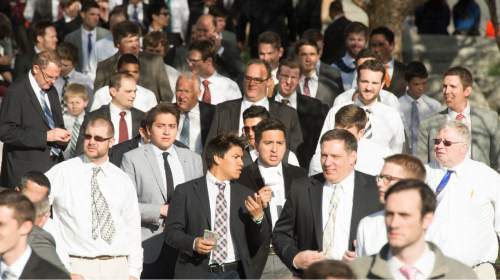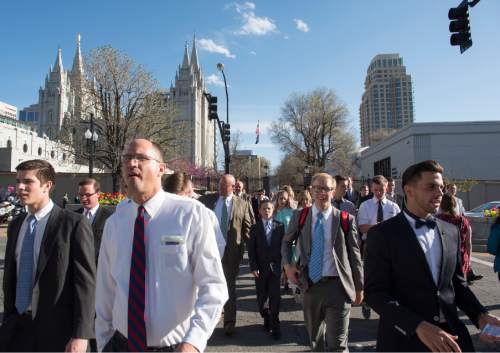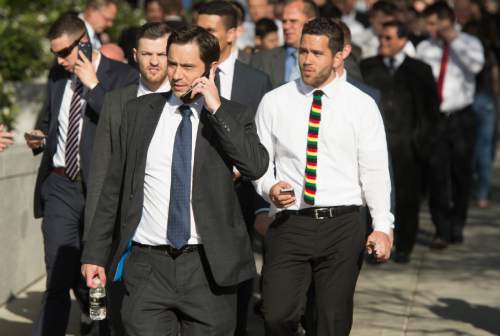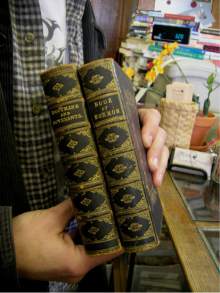This is an archived article that was published on sltrib.com in 2016, and information in the article may be outdated. It is provided only for personal research purposes and may not be reprinted.
In October 2013, we provided an alphabetical guide — spanning from Aaronic Priesthood to Zion — that touched on various theological, historical and cultural topics within the LDS Church.
You can read it online at http://tinyurl.com/zfgcaoe.
Now comes Part II:
Adam-ondi-Ahman • Huh? Well, it's a place in Daviess County, Mo., that Mormon founder Joseph Smith said the biblical Adam retreated to after being expelled from the Garden of Eden, which the LDS prophet indicated was farther south, in Jackson County. So Missouri, the Show Me State, shows up a lot in Mormon theology and will again, according to Smith, when that very same Adam (he of forbidden-fruit fame) returns for a future grand gathering with God and his saints.

Baptism for the Dead • It's not baptism of the dead. Mormons don't dig up corpses and dunk them in water to make them born-again (though deceased) Latter-day Saints. They do, however, dig up genealogies to find the names of departed ancestors. Living volunteers then perform vicarious baptisms for these souls in Mormon temples. A proxy baptism doesn't mean that person automatically becomes a Latter-day Saint in heaven. Mormon doctrine holds that those who have passed on can choose to accept or reject this ordinance. On Earth, those names are not counted as members.
Carthage • When Mormons mention "Carthage," they probably aren't talking about the ancient Phoenician city-state in Tunisia that fell to the Romans in the second century. They instead are referring to the jail where their beloved founder fell to assassins' bullets. Joseph Smith, then a candidate for the U.S. presidency, and his loyal brother Hyrum — along with other top LDS leaders — were confined to this rural lockup in Carthage, Ill., after being charged with destroying the printing press of an anti-Mormon newspaper. On June 27, 1844, a mob of some 150 men stormed the jail and gunned down, first, Hyrum, 44, and then Joseph, 38.
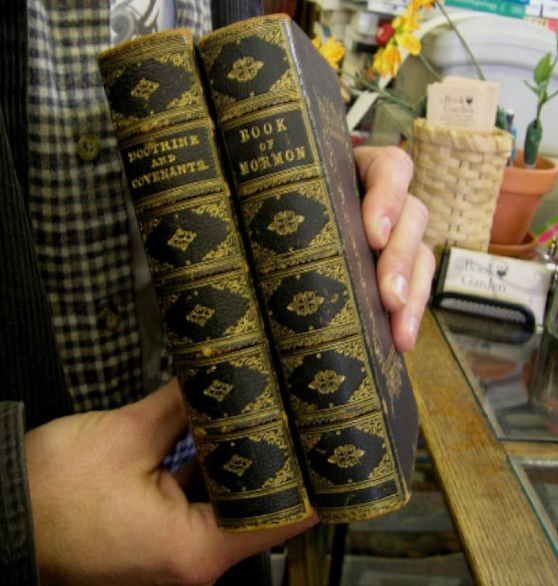
D&C • This isn't referring to the women's surgical procedure. In LDS circles, it stands for Doctrine and Covenants, one of four books comprising Mormonism's sacred canon. Divided into sections, the volume contains "revelations" to LDS leaders, primarily Joseph Smith. The book also includes two historic declarations: one from 1890 that led to the end of Mormon polygamy and another from 1978 that ceased a longtime ban on black men and boys joining the church's all-male priesthood and prevented black women and girls from entering Mormon temples. The D&C — together with the Bible (Old and New Testaments), the Pearl of Great Price and the faith's signature scripture, the Book of Mormon — is part of what is known as the "standard works."
Exaltation • For faithful Mormons, their eyes are on this heavenly prize. It means to live in the hereafter not only with God but also like God. LDS doctrine holds that the Supreme Being dwells in a place called the Celestial Kingdom. Within that sphere are three levels, the top being reserved for those who are married or "sealed" to an eternal spouse in a Mormon temple. So, yes, LDS teachings hold that humans can at some point in the eternities, become like God, but they do not live as God. "God's children will always worship him," says a provocative LDS Church essay on the topic. "Our progression will never change his identity as our Father and our God." So cast aside "The Book of Mormon" musical notion of exalted Mormons ruling their own planets. "While few Latter-day Saints would identify with caricatures of having their own planet," the essay states, "most would agree that the awe inspired by creation hints at our creative potential in the eternities."
Fast Sunday • Typically, it's the first Sunday of every month. Mormons who are physically able go without food for 24 hours and then donate the money saved by skipping those meals (and sometimes much more) to their congregation's bishop, who uses those contributions, called fast offerings, to help the poor. Latter-day Saints also view fasting as a way to boost spirituality and secure special blessings. For younger members just learning to go hungry as a way to draw closer to God, that growling belly is a rumbling reminder that fast Sunday can seem the slowest Sunday of all.

Garments • Colloquially, they're sometimes dubbed "Mormon underwear," a moniker that is essentially true. Adult Latter-day Saints wear these underclothes once they have received their endowment in an LDS temple. The endowment is a symbolism-rich religious rite that teaches the faithful about their eternal relationship with the Almighty and commits them to serve him. Garments, in turn, serve as a daily reminder of those pledges. Two years ago, the LDS Church released photos and a video explaining their purpose, comparing them to sacred attire donned by people of other faiths. "The nun's habit. The priest's cassock. The Jewish prayer shawl. The Muslim's skullcap. The saffron robes of the Buddhist monk," the video intones. "All are part of a rich tapestry of human devotion to God."
Holy Ghost • Mormons buck the traditional Christian creed that views God, Jesus and the Holy Spirit as one substance, a Trinity of divine omnipotent, omnipresent overseers. Instead, they believe God the Father and his son, Jesus, are separate beings with glorified bodies. The Holy Ghost, or Holy Spirit, is the third member of the Mormon godhead and, as the name indicates, is a spirit with no body.
Institutes of religion • There's a big one across the street from the Huntsman Center at the University of Utah and a smaller one near Stanford. These institutes offer Mormon religious instruction to postsecondary students and are available near campuses with sufficient numbers of Latter-day Saints. So while these students are learning about Dickens, Descartes and da Vinci in their college courses, they also are being schooled about Moroni, Melchizedek and McKay at Mormon institutes. Seminaries — located near most public high schools and some junior highs in Utah — do much the same for younger LDS students.
James 1:5 • Mormons love to quote this New Testament verse. Why? Because, they believe, in 1820, this simple scripture prompted a then-14-year-old Joseph Smith to pray about which church to join, setting the stage for a heavenly vision and, eventually, the founding of The Church of Jesus Christ of Latter-day Saints. What does this passage say? In the King James Bible: "If any of you lack wisdom, let him ask of God, that giveth to all men liberally, and upbraideth not; and it shall be given him."
Kimball, Spencer W. • This beloved Yoda-like Mormon prophet, the faith's 12th president, led the global church from December 1973 until November 1985. Dogged by serious health troubles before taking over, Kimball underwent a rejuvenation of sorts — captured in his catchphrases "lengthen your stride" and "do it" — and launched one of the most dynamic LDS presidencies ever. He forever will be remembered for his June 1978 pronouncement ending a centurylong ban on black men and boys holding the all-male Mormon priesthood and black women and girls entering LDS temples. He died on a municipal election night, Nov. 5, 1985, at age 90.
Lucifer • Mormons believe, of course, in God. They also believe in his opposite: the devil. LDS theology teaches that he was known as Lucifer when he lived in a premortal realm with all of Heavenly Father's children. There, he rebelled, was expelled and became Satan, the father of lies, whose hellish mission is to tempt humans to sin against the Almighty.
Manifesto • When Latter-day Saints mention this word, they usually are referring to the 1890 document — issued by the faith's fourth president, Wilford Woodruff — which marked the beginning of the end of Mormon polygamy. "Inasmuch as laws have been enacted by Congress forbidding plural marriages, which laws have been pronounced constitutional by the court of last resort, I hereby declare my intention," Woodruff said, "to submit to those laws, and to use my influence with the members of the church over which I preside to have them do likewise." The practice tapered off dramatically, but hardly disappeared. Church-sanctioned plural marriages persisted, in some form, until 1904, when the faith's sixth prophet, Joseph F. Smith, issued a "Second Manifesto," subjecting those who enter new plural marriages to excommunication. Some splinter groups still preach and practice polygamy. And even mainstream Mormon scriptures describe and defend it. In fact, Mormon men can be "sealed," or married for eternity, in temples to multiple women, but a woman can be sealed to only one man.
New Era • The official monthly digital and print magazine aimed at young Mormons ages 12 to 18 — along with their parents, church leaders and teachers. Its sister publications are the Ensign, the English-language magazine for adult Mormons; the Friend, geared for LDS children; and the Liahona, an international edition distributed in dozens of languages for members of all ages.
Original sin • LDS teaching on original sin is somewhat original itself. While Mormons believe Adam and Eve transgressed against God — bringing death, temptation and suffering into the world — they dispute that their descendants are somehow culpable for the choice made by the Garden of Eden's first couple. "We believe that men will be punished for their own sins, and not for Adam's transgression," states the church's second Article of Faith. That's why Mormons don't baptize babies; infants are born innocent. The church instead baptizes children when they reach a state of "accountability," usually at age 8.
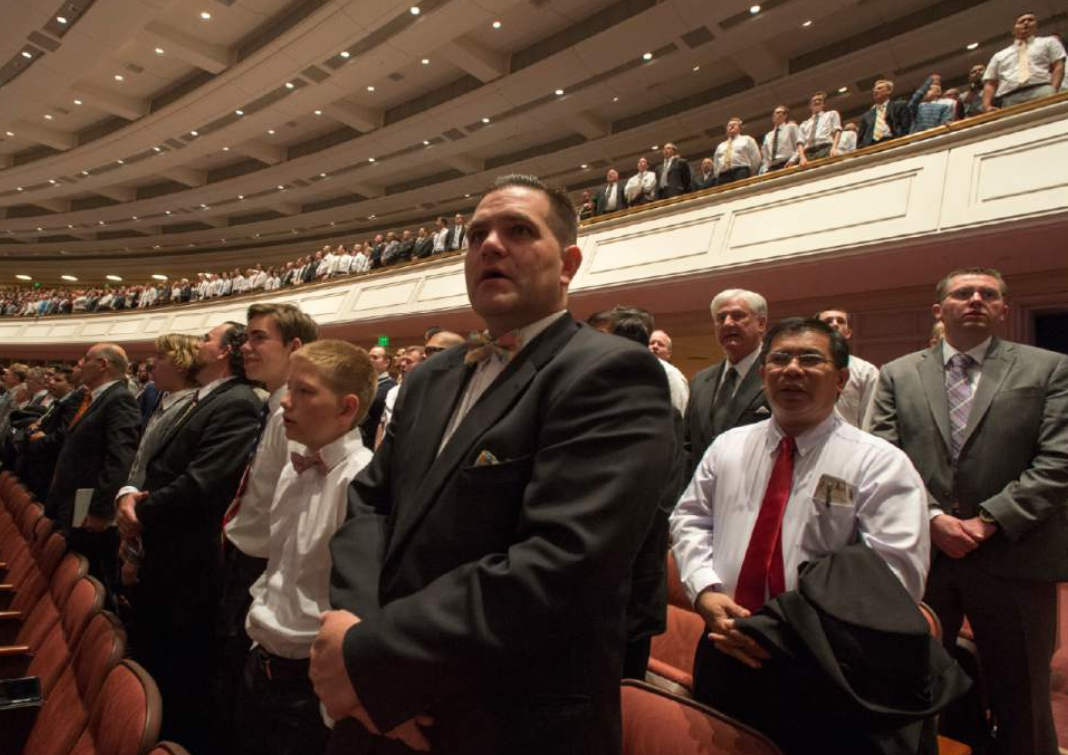
Priesthood • Loosely speaking, it's an all-male group. In fact, when Mormons say, for instance, that "the priesthood will take down the chairs after sacrament meeting," they mean the men and boys who have been ordained to lay priesthood offices. LDS boys are tapped for the priesthood starting at age 12. They can advance from office to office through their teen years and into adulthood, allowing them to perform various ordinances — from passing the sacrament (communion) to baptizing converts. Even so, this authority to act in God's name is exercised not only by men, but also by women in some Mormon temple rites.
Quorum • Priesthood offices are divided into groups called quorums in LDS congregations. Twelve and 13-year-old boys, for instance, belong to a deacons quorum. Many young adult men are part of an elders quorum. A late Mormon apostle, Stephen L. Richards, once said a quorum is "three things: first, a class; second, a fraternity; and third, a service unit." The best-known quorum, the Quorum of the Twelve Apostles, is the second-highest governing body (after the First Presidency) in the LDS Church. The dozen members, ordained as "prophets, seers and revelators," serve for life and are seen as "special witnesses" of Christ. When a Mormon president dies, the governing First Presidency is dissolved and the longest-tenured apostle becomes the global faith's next leader.

Restoration • The LDS Church may be 186 years old, but its teachings, according to its theology, are as old as time. That's because Mormons view their religion as a restored faith, bringing back the true, uncorrupted gospel as Jesus Christ taught it during his earthly ministry and dating back to Adam and Eve and even a premortal world. Latter-day Saints believe this final restoration began in 1820, when the boy prophet-in-waiting Joseph Smith, at age 14, received a divine directive against joining any churches of that day and informing him that the full gospel would be returned to the Earth through him. The Church of Jesus Christ of Latter-day Saints was formally established a decade later, on April 6, 1830.
Sacrament meeting • This is the main Sunday worship service and includes prayers, hymns and sermons (usually offered by members of the local congregation). It typically lasts about 70 minutes. The highlight of the meeting, from which it derives its name, is the sacrament, or communion. Attendees partake of bread and water in remembrance of the sacrifice of Jesus Christ and pledge anew to follow him.
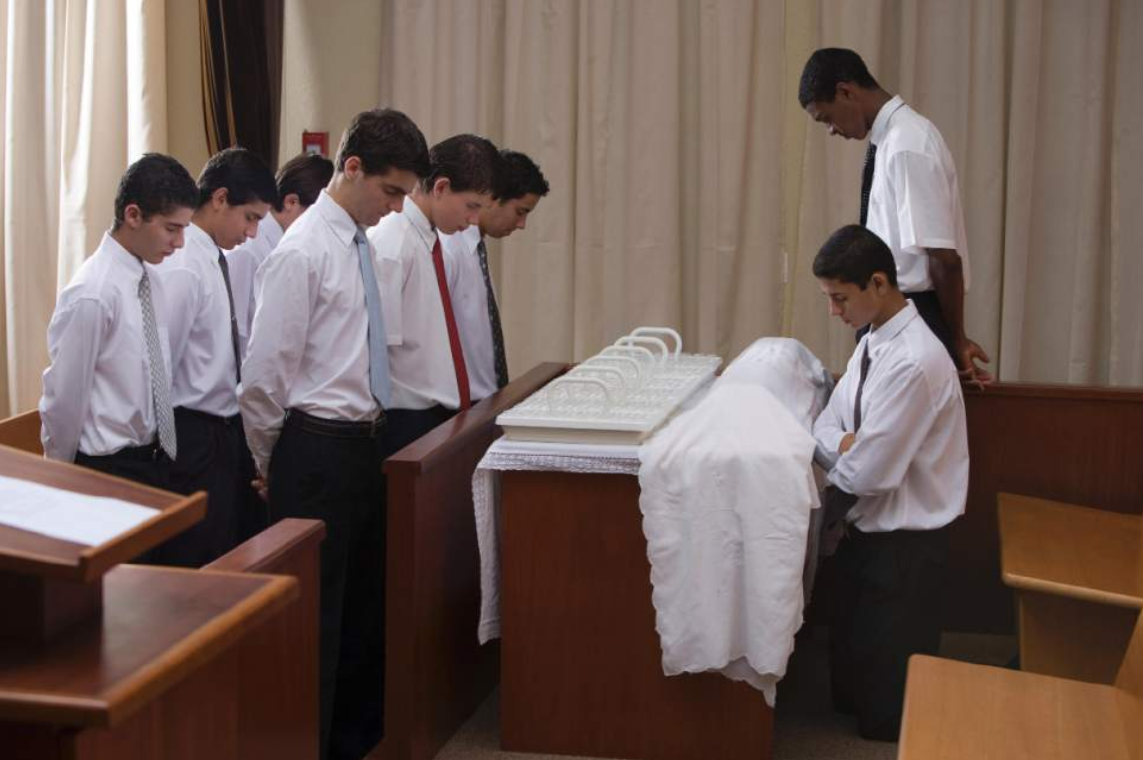
Three-hour block • Ah, but that 70-minute sacrament service is hardly the only Sunday meeting for Mormons. Adults, teens, toddlers, even babes in arms also attend two other services — Sunday school and one of the following: Relief Society (for adult women) priesthood classes (for men and teenage boys), Young Women classes (for teenage girls) or Primary (for children). Overall, the back-to-back-to-back meetings last three hours.
United Order • Early Mormon communities set up economic cooperatives in which participants shared their goods, properties and profits for the benefit of all. The goals: Eliminate poverty, ease income disparities, enhance group self-sufficiency and establish ideal Christian communities. These systems ranged in scale and scope and met with varying degrees of success and failure. Some of the more memorable Utah experiments took place in Brigham City in the north and Orderville in the south.
Visiting teaching • It's the female equivalent of "home teaching." In the latter, male priesthood bearers are assigned to visit households in their congregation monthly to attend to the spiritual and physical needs of these families and individuals. That's the "home" part of the phrase. These priesthood holders — who go two by two, Mormon missionary-style — often "teach" a brief religious message as well during their visits. In "visiting teaching," LDS women are tasked by the female Relief Society to go out, again in pairs, to women in their congregations to do much the same thing while also building sisterhood.
Ward • Mormon congregations are called wards and usually include 300 to 600 members. They generally are organized regionally and are presided over by lay male bishops (professors and plumbers, farmers and financiers, teachers and techies) who live in those respective areas. Smaller LDS congregations are set up as branches. Wards and branches, in turn, belong to larger regional units called stakes, akin to Catholic dioceses. The 15.4 million-member faith now has 30,000 wards and branches throughout the world.

eXcommunication • Mormons can and do, in LDS lingo, get "exed." It is the severest penalty that church leaders — usually at the local level — can exact after a congregant commits a serious moral sin or is found guilty of apostasy. In recent years, Ordain Women co-founder Kate Kelly was ousted from the faith for "conduct contrary to the laws and order of the church" — later labeled apostasy — in her quest to have women ordained to the all-male LDS priesthood. Podcaster John Dehlin got the boot for the same reason. Excommunicated followers are, in essence, no longer Mormons. They lose all the rights and privileges of membership, including any priesthood offices or temple blessings. They no longer can pay tithing or wear temple garments. These believers can and do rejoin the fold — through rebaptism — if they show sincere repentance. "Disfellowshipped" Mormons retain their membership, but their privileges are temporarily suspended.
Young Women • It's an auxiliary program for Mormon girls ages 12 to 17. They attend Sunday classes at the same time that Mormon boys go to priesthood meetings. They also gather regularly during the week to receive more instruction, engage in social activities and perform acts of service.
Zoram • Three Zorams are referenced in the LDS Church's signature scripture, the Book of Mormon. The first and most famous appears early in the text. A servant of an evil overlord, this Zoram winds up fleeing Jerusalem with a heroic Nephi and his band of brothers into the wilderness and eventually the promised land.
Sources: Encyclopedia of Mormonism, lds.org, Salt Lake Tribune archives



